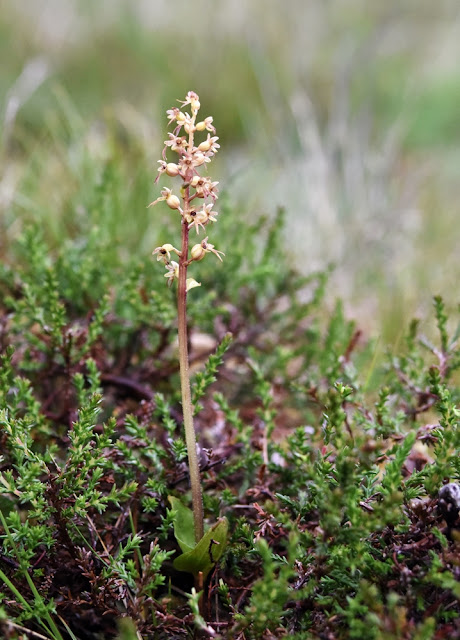Montane moths
 |
| The twin peaks of Spidean Coinich on the southern ridge of Quinag |
After a long cold spell, last week the weather turned bright and warm, although still with a brisk northerly wind. The tops of the hills in the Scottish Highlands cleared and walking there became relaxing and warm compared with the previous week. So I headed up Quinag in Assynt, in the north-west Highlands for a short day on that magnificent little mountain.
 |
| Lochan Bealach Cornaidh in the eastern corrie of Quinag |
I began my walk started from a car park set on a high pass at about 250 m, then meandered through the main corrie, past Lochan Bealach Cornaidh and up the last short steep slope to the summit ridge. The ridge splits into three, leading to the triple peaks. The shortest ridge rises gently up to Sail Gharbh, the highest top at 808 m, which is nice and convenient for a short day.
 |
| The view south from near the summit of Sail Gharbh, the highest peak in the Quinag massif. Canisp, Cul Mor and Suilven rise up behind Spidean Coinich |
Down in the corrie, the heather is tall and mixed with purple moor grass
Molinia caerulea, the dominant grass in these wet heaths. Higher up, the heather becomes shorter as it becomes more exposed to wind. The result is a short sward of mixed heather, grasses and mosses. A soft carpet covers the ground between the scattered boulders making the walking easy for us but living hard for all except the best adapted plants and animals. Ptarmigan are there, although scarce as their preferred food plants of bilberry, and crowberry are sparse, and other foods such as alpine lady's mantle and heath bedstraw are similarly thin on the ground. There were a few wheatears and meadow pipits, hunting for insects and those insects were hiding, such as the Broad-bordered White Underwing moth
Anarta melanopa.
 |
| A well camouflaged moth sits on the prostrate heather high on the ridge, the grey mottled forewings match the colours of the mosses and the pale border of wings matches the twists of white grasses, |
The main range in Britain for this species is withiin the more central Highlands, such as the Cairngorms, so it was especially pleasing to find several individuals out basking in the May sunshine on this north-west hill. They were mostly keeping still, but when any flew they were distinctive in their low tumbling flight, being buffeted by the wind.
 |
| A Broad-bordered White Underwing moth, a true mountain moth that only lives on montane heaths |
Like all animals that live on the high ground these moths have adaptations that give them the ability to survive there. Camouflage is one, and insulation from cold is another. The adults sip nectar from the flowers of the heath plants; bilberry, crowberry and bearberry, which are also the foodplants for their caterpillars. These heaths thrive better on the slopes and lower hilltops, rather than the highest summits in the Highlands, so the smaller hills in the north-west probably suit them and they might be more abundant there than what has been recorded. I'll take notes on other places I find them in future.
 |
| The moths' bodies are clad in a 'fur' of modified scales, even the scales on their wings seem to have a furry texture. All adaptations for life in a cold environment on the mountain tops. |
My day was short on the tops, I had to go back to the valley and the warmer environment. Even with the best of waterproof and windproof clothing I would become cold if I stayed there overnight, and I would become hungry. I like being up on the tops, but I am not adapted to living there. That takes a special type of animal or plant, and I admire them.
 |
| One pair of moths were mating.The warm weather had encouraged them to emerge from their over-wintering state and the main purpose of any adult insect is to breed. The warm period can be short and unpredictable in the hilltops, so they must take the first chance to breed that have. It might be their only chance if a period of cool wet weather settles in before their short life ends. |
























































